The man in this carte-de-visite portrait isn’t identified. Why does he have a blanket wrapped around him? He seems to be pointing at it:
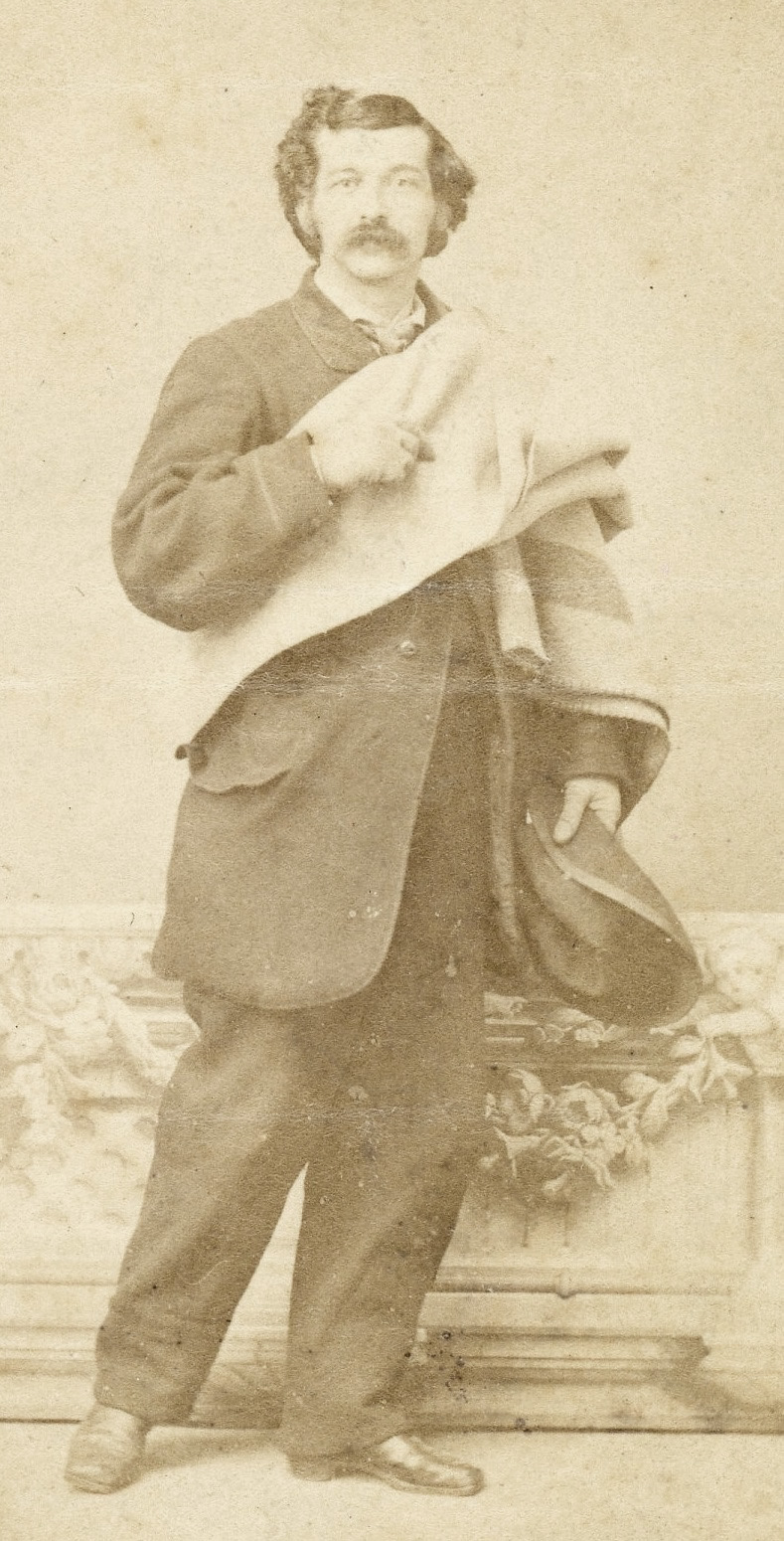
The photographer, Thomas T. Sweeny (1831-1891), worked in Cleveland, Ohio, throughout his life. Although he was active for about three decades, information about him is scarce online. Census records indicate that he was born in New Jersey to parents who had immigrated from Ireland. When he was about twenty-one, he married an Irish immigrant named Mary Wilson, who was about eighteen at the time. They would go on to have ten children (inferred from Census records).
One website mentions that Thomas T. Sweeny opened a studio in 1859 at 249 Superior Street, Cleveland, in partnership with a photographer named Edgar Decker (1833-1905). I assume it was Sweeny’s first studio, but I don’t know for sure. He was about 28 years old.
In 1861 Sweeny served a four-month tour as a 1st Lieutenant in the Ohio Volunteer Infantry (O.V.I.). The Civil War began on April 12, 1861. Sweeny’s tour began on April 22 and ended August 22. He later registered for the draft in June 1863, but probably wasn’t called up, since he had already served. The page with his name on it in the draft registration book is interesting. Of the twenty men listed on the page, only three were born in the United States, including Sweeny. Another of the three, Allen Scott, was Colored (African American). He was born in Michigan and his occupation was Sailor, suggesting he was a mariner on the Great Lakes. Of the other seventeen men on the page, ten were born in Germany, three in Ireland, one in Canada, one in England, one in Prussia and one in Holland. It would be interesting to know how many of these men were called up to bear arms for their adopted country.

(See the full-size scan of the page in a separate tab here.)
The portrait of the man with the blanket could have been made during the war, as late as July 1864. The back of the carte-de-visite is blank. If it had been made between August 1, 1864, and August 1, 1866, it would have had a tax stamp on the back, so we can be certain it wasn’t made during that period. It could have been made after August 1866, but probably not long after. I’m sure it was made in the 1860s. So, what did this man want to convey about himself when he stood in Thomas Sweeny’s studio?


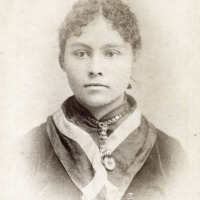
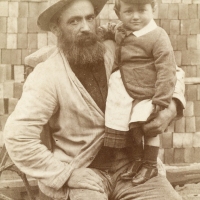
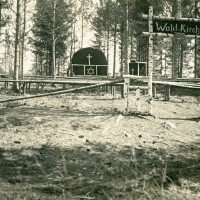
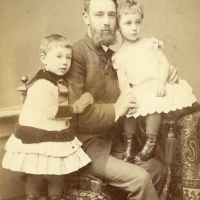
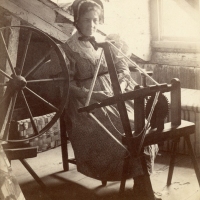
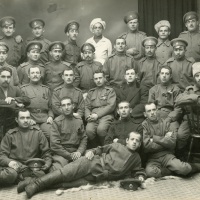
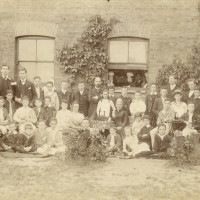
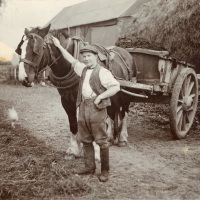
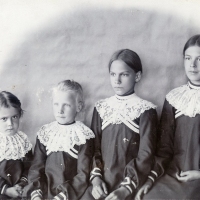
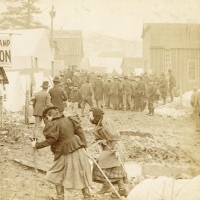
👌👌👌📷✒️
LikeLiked by 1 person
Cheers Mic!
LikeLiked by 1 person
I wonder if it might be a Hudson Bay blanket? Apparently, the early ones had just one stripe at each end. It’s an intriguing photo for sure!
LikeLiked by 6 people
Now you’ve got me wondering what it might signify if it was a Hudson Bay Blanket. Great comment, Liz!
LikeLike
Looks to me as if he is “acting” some sort of statue (Victory?) or angel on a painting…
LikeLiked by 3 people
I also wondered if he might be an actor, but I didn’t want to influence others by speculating. It’s certainly a possibility!
LikeLike
I thought the same as Liz about the blanket. Another fascinating mystery! The man’s pose looks a bit theatrical. Maybe the photo is an advertisement for Hudson Bay Blankets. 🙂
LikeLiked by 2 people
Maybe he was a blanket salesman and he wanted to show how easy they were to carry? 🤔
LikeLiked by 1 person
Photos were not used in ads in the 1860s, but the photo could have been the basis of an engraving. Very intriguing!
LikeLiked by 1 person
Excellent point, Shayne. In the 1861 Cleveland city directory, he was listed as a Photographer and Engraver.
LikeLiked by 1 person
My first thought about the blanket was it’s a Pendleton because they also use bold stripes in their wool blankets. But Liz’s observation about Hudson Bay is more likely since Pendleton, while established in 1863, was in Oregon.
Does the man’s jacket and the hat he holds offer clues? Any relation or resemblance to service uniforms of the time?
For all we know, the blanket was handy and Tom Sweeny thought it would be fun to include, getting people wondering why it’s there as a prop!
Mostly, I’m distracted by the subject’s luxurious mustache and curly mane!
LikeLiked by 1 person
His jacket and hat don’t look familiar, but I’m definitely not an expert on Civil War uniforms. Blankets must have been in high demand during the war, so I can’t help but wonder if there was some connection.
When I first beheld his hair and mustache, I thought he bore a passing resemblance to Mark Twain. Twain was a dapper dresser, though, famous for wearing a white suit. This fellow looks more like a character from one of Twain’s books!
LikeLiked by 1 person
He looks fiercely proud of his blanket, whatever it signifies!
LikeLiked by 1 person
Absolutely! Maybe it was a special blanket of his own design. 🙂
LikeLike
My first thought was that the fellow with the blanket had received it as a gift from some tribe that he’s spent time with. While Navajo chiefs’ blankets are the most famous, there were several tribes that reserved the wearing of blankets to those held in esteem. If the blanket had that kind of history, the man would be rightly proud of it, and would want to show it off.
LikeLiked by 2 people
Oh, I like that theory! I have to say that the man and his blanket seem incongruous with the putti on the wall behind him. Such a Baroque backdrop is unusual, making me wonder if this was actually a theater. He could have been impersonating a figure from Ohio history. On the other hand, even if the photo was taken in a theater, that wouldn’t necessarily mean that the man was an actor.
LikeLiked by 1 person
It just this minute came to me: could he have been involved in declamation? It’s not much in favor these days — if it’s even practiced at all — but it’s the sort of thing that was done individually, and sometimes with a prop or two that emphasized the nature of the presentation. The section on the “classical revival” of declamation here might be relevant.
LikeLiked by 1 person
I’d never heard of declamation before. It makes me think of actors standing on a stage, shouting their lines so people in the back of the theater can hear. Nineteenth century declamation would probably sound stilted to us now. In Britain it was preceded by the Elocution Movement in the eighteenth century. I hadn’t heard of that, either!
LikeLike
Like you and others, I felt this is a very theatrical pose. I like the speculations on the blanket. I learn some cool things from the comments!
LikeLiked by 1 person
This is a case where it’s good to get lots of opinions, because the clues are so ambiguous. Thanks, Eilene!
LikeLiked by 1 person
It’s Mark Twain! Maybe an artist who wanted to look like Mark Twain)
LikeLiked by 1 person
It could be! 😀 Mark Twain was born in 1835. If this picture was taken in 1867 (a guess), then he would be about 32 years old.
LikeLike
I was intrigued by the draft register and the fact that some gave their country of origin as “Germany” (which wasn’t actually a thing at the time) but one more precisely as “Prussia”. “Germany” as a unified country really only starts in 1871, but there had been a movement for decades to unify it. Many had to flee for holding that political view, and I wonder if the people on the register were among them and were making a point by stating “Germany”. But perhaps that is a speculation too far. But the infamous “Deutschland uber alles” originally meant “a unified Germany above all those bitty earldoms etc”.
What you call a Hudson’s Bay blanket could very well have been made in Witney in Oxfordshire, 15 miles from where I’m sitting now…this website tells the story: http://www.witneyblanketstory.org.uk/wbp.asp?navigationPage=North%20America
LikeLiked by 1 person
That’s a very interesting website, thank you! The term “point blanket” is new to me. I have a Hudson’s Bay blanket on my bed, so I’ll have to look to see if it has any points!
I also wondered about the references to Germany in the draft register. It could be that Americans used “Germany” as a catch-all place of origin for German-language speakers, even though the country itself didn’t formally exist yet as a nation state.
LikeLike
This is a wonderful carte-de-visite portrait and mysterious too, since we don’t know anything about him. I love the way the blanket is draped about him. It reminds me of a flag, an honor of some sort and a comfort, perhaps a touch of home. His look is engaging and his stance suggests he’s ready! For what, I wonder. Thank you, Brad! ☺️
LikeLiked by 1 person
Clearly a man of action! Even if, in the modern era, we usually associate blankets with sleep. 😁
LikeLiked by 1 person
😄
LikeLiked by 1 person
It’s surprising to see, in the registry, how many of these men were not born in the U.S. I never thought about immigrants fighting in the civil war.
LikeLiked by 2 people
I was surprised as well. I knew abstractly that some had fought, but seeing the names on the page made it more real. Thanks, Ruth!
LikeLike
He certainly looks fancy. The draft photo was very interesting. Things change fast for immigrants once war enters the picture.
LikeLiked by 1 person
Immigrants faced a lot of prejudice during the 19th century. Most were poor. On the other hand, if they went to war and survived, they gained a lot of respect. It seems like immigrants always have to prove themselves worthy–even now.
LikeLike
Exactly my thoughts. If they went to war. Makes me wonder if this is a kind of use.
LikeLiked by 1 person
Is he wearing gloves? Maybe the blanket is a bedroll, and this guy is part of the cavalry. Although the pants and the shoes don’t look very horsey.
LikeLiked by 1 person
His right hand (pointing) looks like it might be in a glove, but his left hand (holding the hat) doesn’t appear to be. His suit is unusually casual for a studio portrait. The hat might be distinctive, but darned if I know!
LikeLike
Interesting speculations from your readers. It was a theatrical pose and I noticed the way his feet were posed. Today it would look like an advertisement for a blanket with a sultry model.
LikeLiked by 1 person
Yes, his feet seem to give him away as striking a pose. I wonder if he has a connection to the Southwest or Mexico. I know very little about the history of that area.
Imagine a catalog full of people modeling blankets, haha! Who knows, such a thing probably exists.
LikeLike
I wonder if he is in fact pointing at himself or is simply holding the blanket in place. Suspect it would hang down a lot more without some nature of support.
LikeLiked by 1 person
You could be right. Nice to hear from you! I’ll come visit your blog and see what’s happening over there.
LikeLike